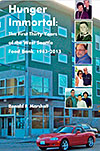book
Hunger Immortal: The First Thirty Years of the West Seattle Food Bank, 1983–2013
by Ronald F. Marshall ’71 :: :: Reviewed by Hannelore Sudermann

What is today the West Seattle Food Bank started as a shoestring operation in an abandoned public school building. A pair of retired grocers from South Dakota had taken on responsibility for distributing government commodities like cheese and peanut butter to needy community members.
Thirty years later, the food bank owns its own building, serves an average of 750 families a week, and distributes food, baby supplies, and other items to a diverse community. The bank also delivers bags of food to the homes of the elderly.
Ronald F. Marshall, a pastor who has served on the food bank’s advisory board for nearly two decades, provides the story of the bank from its scrappy beginnings and through its efforts to meet the needs of a changing, growing community. He blends the chronological story of the bank with small profiles and stories of board members, volunteers, donors, and property owners who made personal sacrifices to provide the bank with a location. “Hunger in our community is far worse than most of us who live here imagine,” he writes, explaining why he undertakes this unusual history filled with intrigue, sadness, corruption, sacrifice, and lucky breaks.
Within a few years of its opening, the food bank’s offerings grew to include food from local donors and groceries. All the while it had to move, and move, and move again, struggling to find a location that it could afford and where the neighbors wouldn’t complain about noise and traffic.
In 1988 the organization became a registered nonprofit. The 1990s brought stability and more community support. Eventually the bank had the resources to provide clothes and books for the clients’ children and to enhance its fundraising. Then, in 1997, a gift came out of the blue. A former longshoreman and building janitor who owned his home and had some savings left $335,000 to the organization. The bequest was a mystery to the board, since the man, a recluse, was neither a significant donor nor a volunteer.
The board decided to use the sum to create a permanent site for the bank. That finally happened, after a number of other donations, in 2007 when the bank opened the doors to its new $3 million home on 35th Ave. SW and Morgan Street.
Marshall cites many reasons for writing this book, including his own curiosity to know more of the story of the bank and the community around it, and his desire to show that “great things come from small beginnings.”